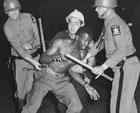
July ’64 2004
Distributed by California Newsreel, Order Dept., PO Box 2284, South Burlington, VT 05407; 877-811-7495 (toll free)
Produced by Chris Christopher
Directed by Carvin Eisen
DVD, color, 56 min.
Jr. High - Adult
History, African American Studies, Urban Studies
Date Entered: 05/26/2006
Reviewed by Timothy W. Kneeland, History and Political Science Department, Nazareth College of Rochester, Rochester New YorkJuly ’64 neatly encapsulates the simmering frustration of African Americans living in Rochester, New York in the summer of 1964 which boiled over into rioting and violence in two city wards. Using archival footage and reminiscences by participants, the documentary paints a picture of a northern city that was uniquely prosperous for upstate New York, a prosperity that made residents “smug.” However, Rochester really was a tale of two cities. The prosperity available to white residents was denied to a growing African American population who were segregated into the third and seventh wards in housing conditions that were sub-standard. African Americans were also segregated economically and denied the opportunity to work for the large corporations in the city. Frustrated at their economic deprivations, incensed by police brutality, and sparked by an incident at a neighborhood block party, a spontaneous riot erupted on Friday July 24, 1964. Three days of violence followed which was aimed at storeowners, police and other representatives of the city’s power structure. The suppression of the “insurrection,” as Cornell University professor James Turner describes it, occurred only when the National Guard appeared on the scene July 26, 1964.
The strength of the film lies in its ability to capture the voices of witnesses to these events and display the vastly different perceptions of whites and blacks in 1964. The filmmakers deftly cut interviews with Frank Lamb, who was the white mayor of Rochester at the time, with interviews of black leaders and activists such as Dr. Arthur Whitaker, Constance Mitchell, and Darryl Porter. The interviews are supported with film clips from that era obtained from local and national news sources. These elements alone make this video eminently suitable for classroom use.
The weakest component of the video is a too brief discussion of the riot’s aftermath. In the short term, local companies ended their overt discrimination of black workers and the city began paying greater attention to black residents. However, the long-term consequences may have accelerated the movement of white residents and economic opportunities out of the city into the suburbs, thus undermining the short term gains achieved. Furthermore, the film does not set the events of Rochester into the broader context of the Civil Rights Movement, which would assist students in better understanding the aspirations and exasperations of those who participated. The best video series on the Civil Rights Movement and urban uprisings in the 1960s still remains Eyes on the Prize (1987).
Recommended for Jr. High – Adult.